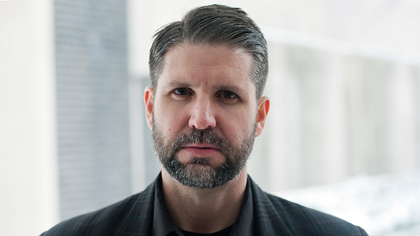archive
Devin Hunter Accepts Faculty Position at University of Illinois Springfield

Photo by Myles Ostrowski
The Department of History congratulates Devin Hunter on his acceptance of a tenure-track faculty position in the History Department of the University of Illinois Springfield. Devin will complete Loyola’s Joint Ph.D. Program in American and Public History, and defend his dissertation on April 23. His dissertation research is titled “Growing Diversity: Urban Renewal, Community Activism, and the Politics of Cultural Diversity in Postwar Uptown Chicago.″ Devin’s new role at UIS will begin this fall, as an assistant professor of American and Public History.
Devin has presented his work to a broad range of audiences, regularly contributes to the blog The Lakefront Historian, and made his GIS maps of Uptown’s historical demographics publicly available through Harvard World Map. He will share key insights from his dissertation in a lecture at the Bezazian Branch of the Chicago Public Library on April 18, 2015.
In recognition of his new appointment and in advance of his upcoming presentation, PhD candidate Nathan Jérémie-Brink posed a few questions to Devin regarding his research, public history, and his thoughts on his new position in Springfield.
How has public history been an important part of your training at Loyola and your work outside the department? How do you feel this expertise uniquely prepared you for your new faculty role at UIS?
The principles of public history inform all of my work, whether it is in an academic setting or elsewhere. Public historians, for example, seek ways to engage people in a variety of registers. We learn to be flexible, patient, and inventive in communicating complex historical themes. These skills served me well when teaching introductory survey courses, and helped me interview people for my research. I also prefer a style of public history that foregrounds communities and collaboration, and embraces controversy. These themes, not coincidentally, surface throughout my dissertation.
Loyola public historians pride themselves on versatility and the ability to place public history into a broad humanistic context. The UIS public history master’s curriculum involves a similar approach. At UIS I will teach across the public history spectrum, from historic preservation to archival administration. I’m looking forward to this challenge, thanks to my Loyola training.
Can you quickly tell us about your research, as if you were explaining it to an interested passenger sitting alongside you on the CTA?
Everybody seems to value cultural diversity. But U.S. urban historians have been relatively slow to investigate what it means to invoke diversity. We often identify Uptown as uniquely diverse, at least in a Chicago setting. How did this characteristic develop, and why did it become such a valuable community identity? We shouldn’t be surprised that the concept has been contested across lines of class, race, and politics. Uptown experienced profound national and international trends after 1950, including urban renewal, migration, poverty, and progressive community organizing. Thoughts about cultural diversity informed--and were informed by--these events.
Since your work takes digital scholarship very seriously, what platforms or tools have you found most important both for your own analysis and for engaging the public? How do you think this experience might also assist you in your teaching?
Mapping has played the biggest role in my research, which is no surprise, given that my dissertation has an explicitly spatial focus. I’ve developed just enough competency to be useful in a range of GIS applications, from ArcGIS to Google Maps. Maps are most valuable when they do more than illustrate, when you learn something from them that you might not have otherwise seen. They’re also powerful illustrations that can have an immediate impact on public audiences. Describing a social process or spatial relationship is one thing, but pointing to it on a map is another. With the sophistication of entry-level mapmaking software and applications like Google Fusion Tables and Omeka’s Neatline, GIS is now within the reach of students. A good map should accompany any student project of significance, these days.
What course do you most look forward to teach at UIS, and why?
All of them! Next fall I will teach a graduate course on material culture, where we’ll consider the meanings of objects on a scale from landscapes to sound waves, and everything in-between. I’ll also teach an upper-division undergraduate course on “The Sixties.” This is a great time for that class, given the visibility of fifty-year anniversaries of important civil rights events and early anti-war demonstrations.
Do you hope to continue your research into Chicago History? What might your ongoing proximity to Chicago mean for your future research and public history work?
I’ll definitely expand my work about Uptown in the near future. Being a train ride away from many of my sources is a great feature of being at UIS. My dissertation ends in the early-1970s, but I hope to expand any book proposal or subsequent articles through the early-1980s. So I’ll enjoy the access to people and places that will help that effort. Proximity to Chicago will also help me develop a key part of my job at UIS---supervising public history graduate internships. My existing connections in the area should be a resource for students seeking internships. Overall, Springfield is a great place to be for a public historian who focuses on Chicago history.
